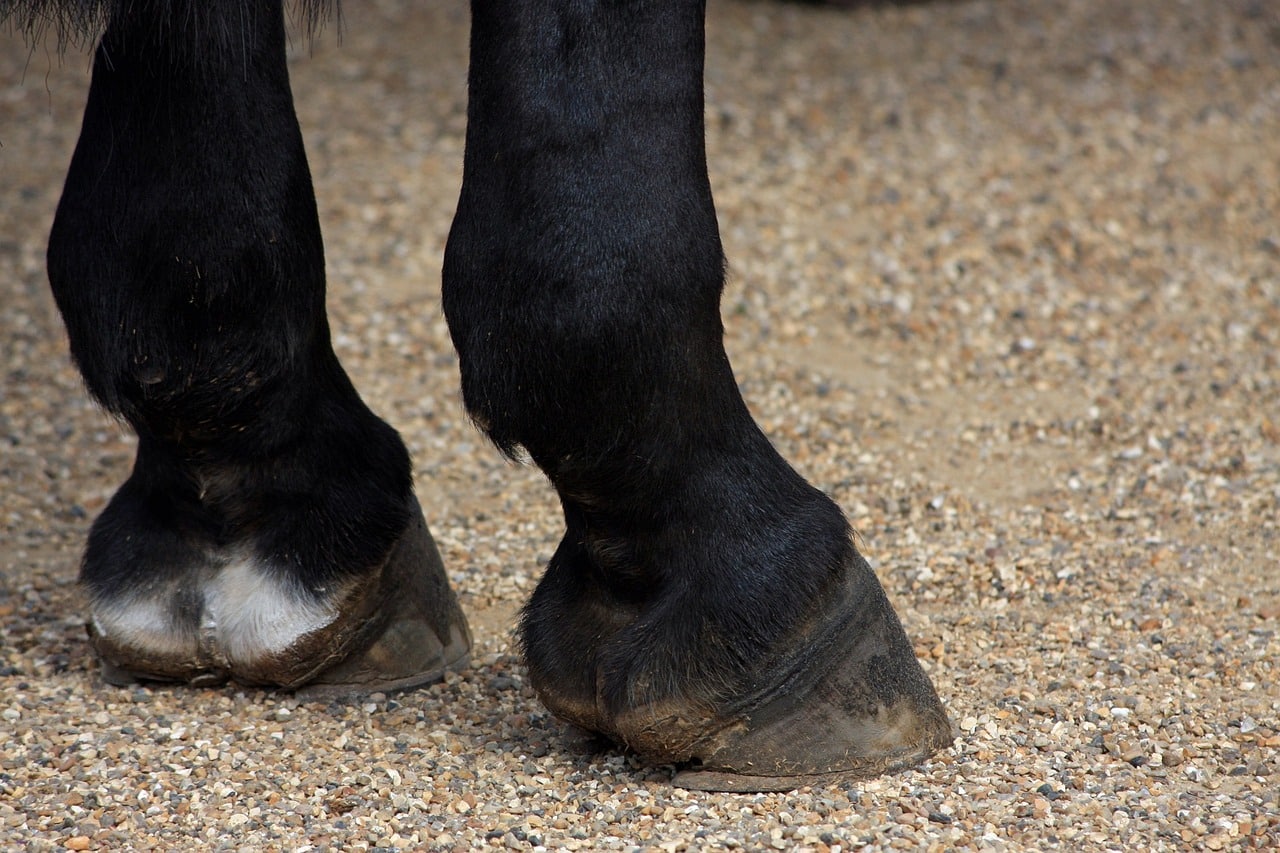
Pixabay photo
If you’ve spent any length of time owning or working with horses, then you are bound to have heard the saying “no hoof, no horse.”
For racehorses this is especially true. “When a racehorse gallops and a single foot is loaded, there can be up to 10,000 pounds of pressure on a foot that is smaller than the average human foot,” says Colby Tipton, a longtime Thoroughbred farrier based in Lexington, Kentucky. “So, let’s appreciate and care for their hooves.”
While some have surmised that Thoroughbreds, racehorses in particular, have “bad feet” to support and carry that weight, Tipton disagrees: “Thoroughbred racehorses do not have bad feet when proper care from the trainer, groom and farrier is applied,” he says.
“I think a lot of the bad reputation Thoroughbred hooves get is from a combination of lighter hooves that are mismanaged,” says Scott Morrison, DVM, who oversees the Rood & Riddle Equine Hospital Podiatry Center, in Lexington. “Many Thoroughbreds have thin integument, thin skin and thin hoof walls. This helps them to be more efficient runners. But the thin, lighter hoof walls also make the feet a little more fragile compared to breeds with thicker walls. However, Thoroughbreds can be managed to have very good, strong feet.”
Racehorse Hoof Care Basics
How often grooms pick the hooves of racehorses in training depends on how wet the ground is (wet environments typically call for more frequent care) or if the animals are being worked that day. Generally, however, they pick out the feet at least once or twice daily, before and after training, inspecting them for rocks or foreign bodies and removing any small pieces of gravel that might be lodged in the white line (the soft, fibrous inner layer of the hoof wall that’s visible around the sole’s edge).
“Trainers know the importance of healthy feet and how quickly … a neglected foot can stop training immediately,” says Tipton.
“Sometimes you can save a horse’s career by identifying a penetrating injury to the foot sooner rather than later,” Morrison says.
Beyond simply picking hooves and being observant, grooms and trainers employ many other hoof care methods. One is the application of topical treatments to the hoof wall. “I recommend a pine-tar-based hoof dressing or even just pine tar thoroughly rubbed into the hoof wall and heel bulbs,” says Morrison. “This provides an all-natural barrier and limits the wet or dry cycles that create weather cracks in the hoof wall.”
“There are many petroleum-based products that are also effective on the outer hoof wall that help maintain hoof quality and prevent dryness and surface cracks,” Tipton adds.
The sole and frog are just as important, if not more important, to pay attention to when caring for hooves. If separations or cavities develop in the white line, the farrier should clean them out with a wire brush or a horseshoe nail, then medicate or pack the area with a hoof putty. “Once the (cavity) is cleaned out, I prefer turpentine on the soles and frog to harden and kill any bacteria,” Tipton says.
Of course, trimming the hooves and resetting shoes are vital parts of racehorse hoof care. “The most common schedule for shoeing racehorses is every three to four weeks, unless an individual horse is slow growing or needs to be shod more frequently to maintain a good hoof and pastern axis,” Tipton says.
Bell boots can help prevent horses from losing shoes during training. “If bell boots are fit properly and extend all the way to the ground, they can help prevent a shoe from being pulled off by another foot,” Morrison says.
Common Hoof Problems
Most trainers are well-acquainted with managing hoof issues such as cracks, thrush and abscesses. However, they rely heavily on their grooms to bring these issues to their attention. The grooms are the ones with their hands on the horses’ hooves multiple times a day. When a quarter crack, abscess or bruise occurs, the horse typically shows signs of lameness, and the trainer notifies the farrier immediately to manage the issue. Typically grooms catch and handle thrush long before it gets advanced enough to jeopardize a horse’s soundness.
Hoof cracks are common problems among racehorses, especially considering how frequently these animals get bathed. “Hooves should have a shiny outer layer, and many feet are dull, brittle and not waxy or shiny,” Morrison says. “When feet do not have a good waxy outer layer, they are prone to moisture and weather changes. This constant change in wet and dry cycles on feet with poor composition will cause those weather cracks. Bathing and the use of detergents breaks down the oils in the hoof and compounds the problem. These feet get too soft, too brittle or shelly and don’t hold a nail well, causing horses to lose shoes, often leading to more nail holes and more damage.”
This is where he often recommends, again, a pine-tar-based dressing, especially before bathing, to prevent cracks from developing.
“For quarter cracks (which occur in the heel quarter), a farrier will sometimes apply a ¾ shoe, 2-inch bar shoe or another type of therapeutic shoe designed for quarter cracks to help treat this issue,” Tipton says.
Racehorses can get sole bruises — not so much because of rocks and hard ground but, rather, pressure from shoes that don’t fit properly or are left on too long. “When racehorses get sole bruises, these sometimes need a full pad and shoe to the cover the entire sole of the hoof,” Tipton says.
Sole bruises or anything else that weakens hoof wall/sole integrity, making it more vulnerable to bacteria, can lead to abscesses. When a racehorse gets an abscess, the farrier pulls the shoe to locate and drain the tract. The groom and trainer receive follow-up care instructions for soaking and bandaging the foot and preventing additional infection so it can heal.
Conformation’s Role
Structure can have a significant effect on how much care, trimming or shoeing a particular racehorse’s feet need. “Hoof conformation is the most important consideration in any athletic horse, especially racehorses,” Tipton says. “I evaluate the entire limb for conformation and then analyze the hoof for deformities, such as a long toe or low heel. Any of these issues can cause quarter cracks, bowed tendons, coffin bone pressure or a severe lack of athleticism and performance. A basic understanding of trimming and shoeing can prevent these issues, along with corrective shoeing, when required.”
The most common hoof conformation problem Morrison says he sees in racehorses is a low or underrun heel. “This is partly genetics and partly man-made,” he says. “Speed training lowers the hoof angle over time. The act of shoeing alone lowers the angle of a hoof as it changes the loading pattern of the foot, because it lifts the frog off the ground. Decreasing the contact area in the heel region puts more stress on the hoof wall and in the heels.”
Building Better Hooves
Trainers can use supplements designed to benefit horses’ feet to help support hoof health. “Biotin can be helpful in increasing wall growth and quality, which is beneficial to racehorses,” says Morrison. “The more often they can replace and grow out hoof, the healthier the hoof will be. The hoof gets stressed and fatigued with time and needs continued replacement.”
He notes, however, that hoof supplements have not been as popular on the track as they tend to be in other disciplines, mainly because racehorse feeds are already fortified with extra biotin.
One way to help racehorses develop better hooves naturally is to allow them to go barefoot, even for just part of the year. “It helps significantly with the strength and integrity of the heels in particular,” Morrison says.
Another method is to avoid using nails in the shoes for a few shoeing cycles. “Sometimes it’s worth spending the extra money upfront to glue shoes on a few times to help increase foot mass and to let the nail holes grow out,” he says. “This is a good way to transition a horse to barefoot and could save money in the long-term.”
Overall, racehorses experience most of the same hoof care and foot issues as any other equine athlete, and regular cleaning, trimming and shoeing can help keep them sound.
“A racehorse’s hoof hits the ground with extreme pressure, and even with their finer makeup, I am amazed on a daily basis at how properly maintained hooves can do amazing things,” says Tipton.

